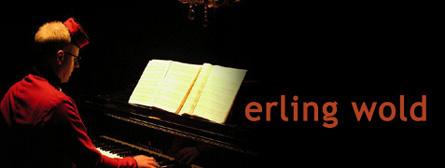 Notes for a variation on Torna a Surriento:
Notes for a variation on Torna a Surriento:Although my father was capable of some puccaloistic whistling, most of my musical talent came through my mother, who played in a piano-laden ersatz orchestra in her youth, a not uncommon animal in those areas bereft of a bona fide heterogeneous ensemble, performing multi-piano arrangements of familiar melodies, such as her favorite, my countryman Grieg's In the Hall of the Mountain King, whose inexorably testosteronic accelerando rubbed her and her fellow pianistes to the brink of ecstasy. But the LP most in rotation in my boyhood home featured the trademark cascading strings of the Mantovani arrangements of Italian melodies, including Come Back to Sorrento, a calorie-lacking fluffball that I still cannot hear without bawling like a little baby, and a few flavonoids of which I have stolen for my variation here for an ensemble sadly lacking the three thousand strings necessary.
I happened across Scott D. Strader's blog recently and, reading his comment on Prokofievization, realized that I often do a bit of the same, but especially so in this number, since it started with someone else's tune and harmonies, and I needed to make it my own. The process looked something like this:
1. scribbling the original tune into the score - may as well keep the original key;
2. sketching an orchestration of the tune and the chords, by which I more properly mean arranging, where some notes and rhythms exist and one has to scatter them about, but stealing a few ideas as mentioned above from the Mantovani, e.g., the tremoloed strings and guitar;
3. do more of the actual orchestration, i.e., the orchestra-as-an-instrument parts. Who was it that said, when looking at a workmanlike orchestral arrangement of a piece for piano, that it was now time to orchestrate the pedal? So, adding the pedal effects and swirls and swells, an iterative process;
4. at the same time as (3), listening to every YouTubed version of Return to Sorrento and Torna a Surriento and realizing that every single singer who sang the original in all its golden age of opera glory performed the rubati and ritenuti in exactly the same way, so deciding to notate that into the score, requiring some stretching of time signatures here and there;
5. at the same time as (3) and (4), getting bored with the whole thing and remembering the rhythmically unpinned viola in Berio's setting of Black is the colour..., and deciding to write some other, more typical music to start it and to interrupt it and shoehorning that into it, streamlining the harmonies to make them a little less ploddingly obvious, adding some seasoning of the carousel;
6. sleeping on it, revising, repeating;
For 90 seconds of music, it was more difficult than usual, probably because I was starting with something that didn't sound much like me, and, even though constraints can sometimes be liberating, feeling bowed by all the baggage carried by this particular melody. But, even when writing things of my own from scratch, it is rare that I trust the first draft. There is always a process that follows of both honing and embellishing, of adding to and stripping away.





No comments:
Post a Comment